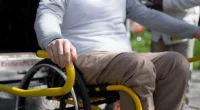Bedsores, also called pressure sores, happen when someone stays in one position for a long time. They can make the skin change texture and color and can even become open wounds that might get infected.
These sores are like wounds that form because of pressure on certain body parts, especially bony areas like elbows, heels, knees, ankles, and tailbone.
Even though we can treat these sores, sometimes they don’t fully heal. If they’re not treated, they can cause very serious problems, even death.
A study from 2015 found that 3 million population in the United States have pressure sores, and those who can’t move easily are at the highest risk.
Treatment
Regularly changing positions is crucial for helping pressure sores heal and preventing new sores from forming. In the early stages, people can often treat these sores at home, but severe ulcers require attention from a healthcare professional.
Specific measures for treating pressure sores depend on the sore’s stage. Generally, relieving pressure by using pillows or foam pads, and changing the body’s position frequently, is important. Cleaning the wound with mild soap or a saline solution and applying dressings can help protect and heal the area. Topical creams, like antibacterial or barrier creams, can prevent infections and protect the skin.
Managing incontinence is also crucial, and products like cleansers, protective creams, and incontinence pads can help. Removing dead tissue is another important step, and doctors may use different methods for this, such as high-pressure hydro jets or surgical tools.
Choosing the right bedding is also important. Special mattresses like dynamic or static foam mattresses can help reduce pressure, and few beds have a pump for a continual flow of air. Additionally, antibiotics may be necessary to treat infections, and adjusting the diet, particularly with protein supplementation, can aid in healing and overall health.
In some cases, surgical options may be considered, such as removing dead tissue, cleaning the lesion, and possibly using healthy skin to repair the area. Other treatments like vacuum-assisted wound closure, hyperbaric oxygen therapy, or electrical stimulation may also be beneficial.
Stages
Pressure sores happen in four stages:
- At first, the skin might feel warm and look different, like it’s red. It might also feel itchy.
- Then, a painful sore or blister forms, and the skin around it changes color.
- After that, the sore looks like a crater because the tissue underneath is damaged.
- In the worst stage, the tissue and skin are severely damaged, and there might even be an infection. You might even see muscles, tendons, or bones.
When a sore gets infected, it takes a longer time to heal. The infection can spread to other parts of the body and cause serious problems.
Prevention
Prevention is key when it comes to avoiding pressure sores. Here are some helpful tips:
Firstly, it’s important to change positions regularly. This could mean shifting every 15 minutes to 2 hours, depending on what the person requires.
Additionally, it’s crucial to check the skin regularly for any changes or signs of pressure sores. Keeping the skin neat and dry also helps to prevent these sores from developing.
Maintaining a healthy diet is important too. Good nutrition supports overall skin health and can help prevent pressure sores.
Avoiding smoking and secondhand smoke is also essential. Smoking can reduce blood flow to the skin, making it more susceptible to pressure sores.
Even while lying in bed, doing exercises to promote circulation can be beneficial in preventing pressure sores.
Lastly, if anyone suspects they may have a bedsore, it’s important to inform their caregiver or a doctor as fast as possible. Early detection and treatment can help prevent the sore from getting worse.
Causes
People who remain in one position for extended periods are at risk of getting pressure sores, particularly those who may require assistance with changing positions.
Factors contributing to the development of pressure sores include spending prolonged periods sitting in a chair or sleeping in bed, wearing prostheses or surgical devices, and wearing poorly fitting shoes or elastic clothing.
These sores occur when blood vessels and tissues are compressed and distorted, leading to impaired circulation, tissue damage, and potential infection.
Pressure sores can result from either significant pressure within a short period or prolonged, low-pressure exposure. Both scenarios can lead to tissue breakdown and the formation of pressure sores.
Symptoms
Symptoms of a bedsore typically include changes in the color and texture of the skin. Dark skin might turn purple, bluish, or shiny, while light skin may appear red, pink, or dark. If discoloration persists after removing pressure for 10 to 30 minutes, it may indicate the formation of a sore. Additionally, the affected area may feel spongy or hard and warm. If the skin breaks, there can be a shallow, open sore with pus or fluid, possibly extending into deeper tissue layers. Signs of infection include changes in color or sensation around the sore’s edge, increased pus, black or green tissue, and fever.
Pressure sores tend to form in areas subjected to prolonged pressure. For individuals spending extended periods sitting, common sites for these sores include the buttocks, tailbone, shoulder blades, and spine, behind the arms and legs. Conversely, those confined to bed may develop sores on areas like the heels, ankles, tailbone, shoulders, elbows, or behind the head. These locations are especially vulnerable due to consistent pressure against the bedding or support surfaces.
Risk factors
Certain things can make it more likely for someone to get pressure sores:
- Difficulty Moving: If someone can’t move easily by themselves, they’re at higher risk.
- Getting Older: As people get older, their skin becomes slender and more delicate, which can make them more prone to pressure sores.
- Incontinence: Having trouble controlling the bladder or bowels can increase the risk of skin infection and damage.
- Body Weight: Having a very low or very high body weight can put extra pressure on certain parts of the body, making pressure sores more likely.
- Low Body Weight: If someone is very thin, they might not have much padding around their bones, making them more vulnerable to pressure sores.
- Certain Health Conditions: Conditions like diabetes can reduce the ability to feel pain, making it harder to notice and treat pressure sores. They can also slow down the healing process.
- Impaired Blood Circulation: When blood doesn’t flow well through the body, it can make skin more prone to damage and slow down healing.
- Decreased Mental Awareness: If someone isn’t fully aware of their surroundings or their own body, they might not notice the early signs of pressure sores developing.
Complications
Pressure sores can cause serious problems if they’re not treated.
For example, one complication is cellulitis, which is a dangerous bacterial infection that can spread from the skin’s surface down to its deepest tissue layers.
Cellulitis can even move to other areas of the body and lead to more issues, like sepsis. Sepsis is a very serious infection that can make organs fail and can be life-threatening.
Also, if a pressure sore goes deep enough, it can lead to infections in the bones and joints. These infections can hurt the tissue and cartilage, making it harder to move your limbs and joints.
Outlook
You can usually lower the chances of getting pressure sores. If a sore is just starting, you can often take care of it at home. But if it’s more serious, you might need help from a doctor.
The best thing to do is to try to stop these sores from happening in the first place. And if you notice one, it’s important to start treating it right away.
Summary
Pressure sores, caused by prolonged pressure on the skin, can lead to serious complications like infections and reduced mobility. Risk factors include immobility, older age, and certain health conditions like diabetes. Symptoms include changes in skin color and texture, and sores often form in areas with constant pressure.
Prevention involves regular position changes, maintaining good nutrition, and keeping the skin clean and dry. Complications can be severe if left untreated, such as cellulitis and bone infections. Early detection and treatment are key to managing pressure sores and preventing further complications.
External links









